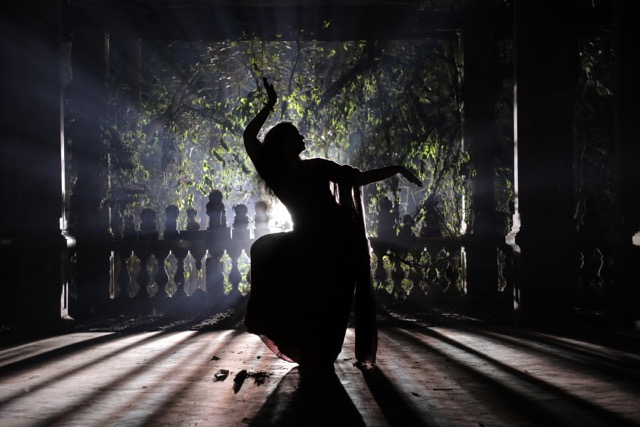Methil Devika is an India based classical dancer, educator, scholar and proponent of the Indian Classical Dance Form of Mohiniyattom. She has created an extraordinary documentary short film entitled Sarpatatwam – The Serpent Wisdom that has been screening at Valley Plaza 6 in North Hollywood, Regency Theater at 2:45 pm with one more on Thursday, September 27. The running time for the film is just under 30 minutes and is primarily in English. This is Methil’s first film, but her dance concerts have been seen in the USA, Europe, Australia, Esplanade Theatre Singapore, and at major festivals like the Kerala Fine Arts Society and the Ustad Bismillah Khan Yuva Puraskar youth festival.
The snake, or serpent, plays a prominent role in many cultures. The Hindu mythology infuses the serpent with God-like qualities and it is treated with fear as well as with reverence. The classical dance form Mohiniyattom dates to the 11th century. The dancer interprets the serpent’s movements as it coils, unfurls and glides through its often-hidden pathways. Methil has worked to redefine Mohiniyattam by exploring universal human emotions, giving lecture-demonstrations and paper-presentations in various schools and institutes in India and in Universities abroad. In 2017 she made her film debut in Humans of Someone directed by Sumesh Lal. Methil conceived, choreographed, directed, co-produced and performed in Sarpatatwam, and the film was produced by a crew in Kerala India.
In the opening frame we learn that throughout history the Siddhars were a group of Indian mystic physicians. They were masters of Yoga, free spiritual thinkers and alchemists. Pambbati Siddhars who is believed to have lived during the 11th century, was the most famous of them and the latest of the 18 Siddhars. He was a poet, a snake charmer and a spiritual philosopher. He obtained the eight superpowers, Ashtami Saddhi, after doing penance for a long period of time living in a cave. He then used the serpent as a motif in his many writings about the awaking of self and in his verses to explain the philosophy behind this process. He generally ended his verses with the appeal “Dance Thou Cobra” and Methil has interpreted of the text from some of his writings.
At first, we see Methil through the eyes of the serpent as it follows her through what looks to be a jungle. It watches as she sits on a branch and stands meditatively by a pond. We hear her speak about her childhood fear of snakes, but through experience and spiritual exploration she has gained a new respect for these creatures. She explains why she decided to create a work to the writings of Pambbati Siddhars and that it is not an ode to a snake, but “the intelligence behind spiritual maturity though altered states of consciousness.”
The cinematography is rich with the greens and browns of the jungle, mixed with halos of blurredness to portray how the serpent sees this human and the world around her. Methil explains how the serpent’s relationship to our consciousness is understood in Yogic Kundalini, a form of Indian philosophy. I was struck by the statement that the serpent is seen as one who both confines (the physical being) and one that releases (the spiritual being). Methil states that she is presenting to her audiences “the philosophy of the Siddhars through music and movement indigenous to Kerala, [and] I understand the serpent power as one that has connected us through time and beyond.”
The serpent follows the woman to an opening that is the location of a somewhat dilapidated temple. Here, her daily attire is magically and mysteriously transformed into the classical dancer’s costume and make up. Her gorgeous costume is primarily white with green sleeves and accessories; the skirt trimmed with gold. Upon her head sits a coiled Cobra. Her arm movements begin to resemble the movements of a snake and later, her hands form of a cobra’s hood shortly before it strikes.
The serpent moves around the dancer’s head and eventually the dancer takes on the serpent’s persona as she translates through movement the writings of Pambbati Siddhars. The text is beautifully sung by Aparna Sharma. As the snake, the dancer’s movements take her to the floor, her arms becoming the cobra’s head. She mimes the coiling movements and stands to demonstrate the serpents slithering motions. She gracefully moves across the floor on her knees as the words sing out to the snake “Raise your hood and dance.”
The choreography is exciting in a very subtle way as the dancer shifts between the physical and the spiritual. The colors of the costume and the surrounding jungle contrast with the grayness of the temple’s floor which only adds to the film’s texture and beauty. Methil’s physical transformation into the serpent, including her facial and eye movements is almost hypnotic. During one section, Methil is seated in a low first position plié, her eyes closed as she goes through a long series of hand, finger and arm movements. The position itself is difficult to hold, but to balance and perform these movements would be challenging to most.
As can only occur in film, a stunning and articulately drawn sand painting of a serpent that incorporates the five natural colors representing the five elements, magically appears on the floor beneath the dancer’s feet. As she moves in a circular fashion, she slowly and deliberately destroys the painting, mixing all the colors together into a grayish blur.
The dance takes up much of the film, but the last ten or so minutes Methil is interviewed by Ian Seth Who asks how she was drawn into the world of the serpent and its mystical powers. He leads her to explain not only her inspiration, but her journey through the process, the spiritual mysticism behind the writing, and what the destruction of the gorgeous painting represents.
This film and Methil Devika’s performance are not only beautiful to watch, the singing of the text is wonderful to hear and the information Methil shares with the viewer during her interview contains important and educational knowledge for all who might not have experience with Indian dance or culture. I wish that I had had more time to publish this review sooner because it is a documentary/performance that I highly recommend one seeing. Hopefully, it will have a longer viewing elsewhere Los Angeles and elsewhere.
The co-producers for Sarpatatwam are Methil Devika and Mukesh. Directed by Rajesh Kadamba and Methil Devika. The Editor is Alby Nataraj. The Director of Photography is Vipin Chandran. The musicians are Aparna Sharma (vocal); P. Jayasankar (Mridangam); V. Soundarrajan (Veena); Shrikumar (violin); and Sajith Pappan (Edakka, Maddalam, Chenda). The costume is by Reyma Suresh, Suma Nair, and Shivakumar S.R. Makeup is by Suma G.
Featured image: Methil Devika in Sarpatatwam – The Serpent Wisdom – Photo courtesy of the artist.
Below is the trailer for Sarpatawam – The Serpent Wisdom.








